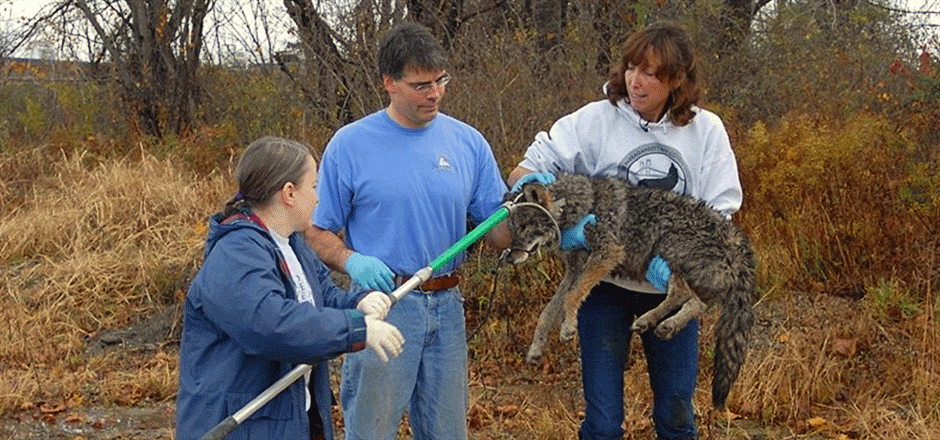Why study coyotes?
A native of the western plains, the coyote has extended its range to the eastern United States over the past 100 years. Thanks to interbreeding with wolves, the eastern coyote is larger than its western counterpart, leading some (we are not among them) to call it a “coywolf” and to advocate for its reclassification as a separate species.
The presence of coyotes has been well documented throughout New England and the mid-Atlantic states. Coyotes were first seen in Rhode Island in the 1960s and can now be found in all parts of the state except Block Island. They have gradually expanded their range from farmlands and open space into suburban and urban areas and have successfully established themselves as the region’s top predator. As such, their presence has been keenly felt by farmers and others whose livestock and pets have fallen victim to their attacks.
Coyotes may also be a keystone predator, which means that their presence could have a much more significant impact. When wolves were reintroduced into Yellowstone back in 1995, it was found that they set in motion a chain of events that literally altered the landscape. The process is dramatically illustrated in a short video entitled How Wolves Change Rivers.
While the behavior and impact of wolves have been very well studied, the same is not true for coyotes, especially those in the eastern states. Yet these wily animals are rapidly filling the niche left open by the wolf’s disappearance from this part of the country. Unlike wolves, coyotes are highly adaptable and capable of living in close proximity to humans. And, unlike wolves, they are probably here to stay.
The more we know about coyotes, the better equipped we will be to manage their numbers and any impacts they may be having on our biological and human communities.
Narragansett Bay Coyote Study (NBCS)
 Coyotes arrived on Aquidneck and Conanicut Islands in the mid-1990s, most likely by swimming or making their way across the bridges. In the years that followed, their numbers appeared to be on the rise, as indicated by the increase in sightings and complaints.
Coyotes arrived on Aquidneck and Conanicut Islands in the mid-1990s, most likely by swimming or making their way across the bridges. In the years that followed, their numbers appeared to be on the rise, as indicated by the increase in sightings and complaints.
In 2005, The Conservation Agency, based in Jamestown, launched the Narragansett Bay Coyote Study (NBCS) in an effort to identify the factors contributing to the growth of the islands’ coyote populations and the increase in human-coyote interactions.
Since its inception, NBCS has used advanced GPS tracking, combined with visual surveys, to understand coyote distribution, patterns of movement, and resource use on Aquidneck and Conanicut Islands. From the data collected, NBCS was able to estimate the number of resident packs on both islands and to plot the movements of both resident and non-resident (transient) coyotes. These movement patterns showed that both resident and transient coyotes were heavily dependent on a wide range of food resources made available to them by humans. These include livestock carcasses and road-killed deer, feral cat colonies and outdoor pet feeding, free-ranging small pets, and food waste in garbage and compost. Later data also pointed to some less obvious sources such as fishing remains at boat ramps and fallen or low-hanging fruit.
These findings led to the development of a set of Coyote Best Management Practices that have since been adopted by all four island municipalities (Middletown, Portsmouth, Newport and Jamestown). They also resulted in the adoption of wildlife no-feeding ordinances by all four municipalities and the tightening of Rhode Island state regulations to prohibit coyote attractants.
NBCS 5-year coyote research project (2018-2023)
Based on its findings to date, NBCS has hypothesized that limiting food subsidies will reduce coyote numbers, along with coyote traffic, habituation, and human-wildlife interactions. This hypothesis will be tested in a 5-year research project funded at $1.1 million by the RI Department of Environmental Management under the Wildlife and Sport Fish Restoration Program of the U.S. Fish and Wildlife Service.
CoyoteSmarts is pleased to provide in-kind support for this important project.
![]()
Federal grant to fund new coyote study—Newport Daily News, Oct. 12, 2018. The project is announced, its goals are explained, and help is sought from local communities in identifying coyote “hotspots.”
With goal of population control, RI coyote study underway—WPRI Channel 12 Eyewitness News, Nov. 5, 2018. The first coyote in the study is collared and released in South Kingstown.
How coyotes and humans interact in R.I.—Providence Journal, Dec. 14, 2018. An op-ed by the RI Natural History Survey and CoyoteSmarts describes the project and enlists the public’s help.
Coyote food removal study meets with early success—Newport Now, July 11, 2019. As shown in striking before-and-after images, early findings from the Portsmouth study area are very encouraging.
GPS collar reveals easy pickings–food left outdoors–a magnet for coyotes—Providence Journal, July 23, 2019. Study shows that if people stop feeding coyotes, the animals will stay out of residential areas and stick to their natural habitat and diet.
DEM to host virtual outreach program on coyotes—RI Dept. of Environmental Management press release, Aug. 6, 2020. The program is open to the public and will give participants a behind-the-scenes look at the NBCS coyote research project. To watch a video recording of the program, click here.
Coyote study comes to Providence—Providence Journal, Sept. 22, 2020. An op-ed by the RI Natural History Survey and CoyoteSmarts discusses the study’s findings in Roger Williams Park.
Meet the zoo’s wild neighbors—WILD Magazine, October 2020. An article in the Roger Williams Park Zoo’s online magazine describes the research being done in the neighborhood around the Zoo.
Coyotes tagged at Watson Farm—Jamestown Press, Feb. 4, 2021. NBCS researchers hope that the two collared coyotes will lead them to food resources provided by local residents.
What happened to Sherlock the coyote? Case is solved in Jamestown—Providence Journal, April 16, 2021. The research coyote named “Sherlock” dodges a bullet by leading her handlers to the spots where she was being fed.
Coyote expert says improved human behavior is evident—Jamestown Press, Oct. 7, 2021. Coyote numbers and encounters are decreasing in Jamestown, RI, and change in human behavior may be the reason.
Would-be trapper making Newport coyote problem worse—Providence Journal, April 8, 2022. “Deer smorgasbord” used to bait coyotes is uncovered by GPS-collared coyote appropriately named “Clouseau.”
Photo credit: ©David Hansen, Newport Daily News


